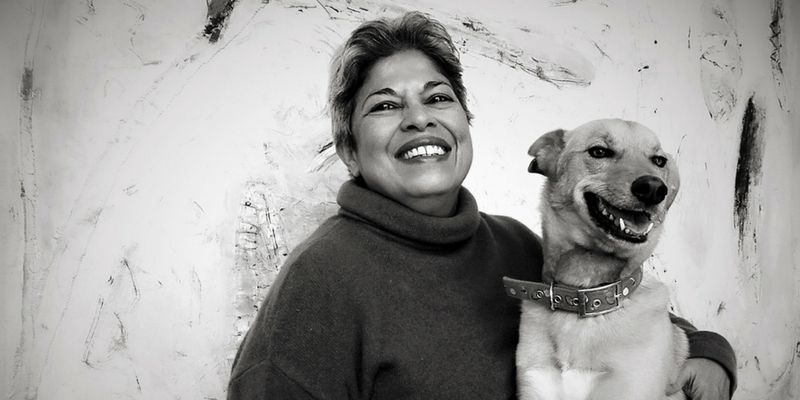Poet, writer, and artist Tanya Mendonsa speaks of healing and discovery in her latest work
Tanya Mendonsa has exhibited her paintings widely, but poetry remains her focus. She speaks to HerStory about her past works and her latest one, The Fisher of Perch, which she describes as a ‘fable for our times’.

Critically acclaimed author and poet Tanya Mendonsa has launched her latest work, The Fisher of Perch. It’s a poem of discovery and of healing. Its theme is one of renewal, a gentle and benevolent erosion of the past and the self by the river, which is at the heart of the poem. Drawing deeper parallels between the connections of water and self, Tanya's verses investigate the relationship with critical tenderness.
The Fisher of Perch comes on the heels of The Book of Joshua and All The Answer I Shall Ever Get.
As a poet, writer, and a painter, Tanya feels that each discipline feeds the other. After graduating in English literature from Loreto College, Kolkata, she moved to Paris at the age of 21 to paint and major in French literature at the Sorbonne. To support herself she ran a language school where she taught English to French to corporate organisations – this was also her first business venture.
After 20 years in Europe, she returned to India to live in the river-laced village of Moira in Goa, with abstract painter Antonio E Costa, and two dogs and two cats. She wrote her first book of poetry, The Dreaming House published by Harper Collins in 2009, here.
In a conversation with HerStory, she speaks about her latest work, inspirations, and how poetry is influenced by emotions.

HerStory: When did you take to the arts and writing?
Tanya Mendonsa: I always wrote stories and poems from the time I was a child and won all the essay prizes at school, but was rotten at maths. When I was a teenager, I started painting in oils – only figurative work – and had my first solo exhibition at the age of 19. I’ve read almost a book a day since I was 10 years old and, of course, my years in Paris exposed me to wonderful museums and galleries.
HS: What prompted your first book? What is it about?
TM: I am a late bloomer. It was only when I came to live in the exquisite village of Moira in Goa that I felt ready to write a collection of poetry. This was conceived of as a journey – in both geographical and spiritual terms - within a book.
The first part, The Voyage Out is largely composed of poems about people I had met – whether in real or imaginary life – and about wars, which were primarily internal or between people.
The second part, The Country Beyond focuses – almost in a trance of delight - on the redeeming qualities of the natural world and the way it can change human beings. This world, in all its Indo-Portuguese beauty in Goa, was on the cusp of vanishing, under a tide of political and real-estate greed.
The language is spare but lyrical; like Gabriela Mistral, the Chilean poet said that “all lyric poetry was caused by the wound of love.”
HS: Can you tell us more about your other books?
TM: My first work of non-fiction, The Book of Joshua, is a memoir, with a blurb by Jilly Cooper and was published by Harper Collins in 2012. It was written after I moved to the Blue Mountains of the Nilgiris with our animals, the most beloved of whom was our cocker spaniel, Joshua, then over 13 years old. I wanted to write about my life with animals I had known as well as him before he left us and this took me from India to all over France and back to India, with the last section set in Bangalore, Goa and, finally, the mountains. The book wrote itself, because everyone in it – the animals and the humans - were so close to me, especially, of course, Joshua, who was the star, the love of my life, and who appeared in all his beauty on the cover – good enough to eat with a silver spoon, as the French say.
All the Answer I Shall Ever Get, my second collection of poems, was published by Harper Collins in 2016, with a blurb by Chitra Banerjee Divakaruni, a childhood friend. It is an exploration and a meditation on two eternal themes: love and friendship, and the power of the past.
My work remains rooted in the classical tradition, but it speaks, simply and directly, to the heart. I went further in my exploration of a universe of grief balanced on the edge of radiance.
HS: What is The Fisher of Perch all about? What is it influenced by?
TM: The Fisher of Perch is a long poem in short verses; a poem of healing and discovery. It was written over three years, in between my other books and projects, so the evolution was as gentle and natural as the story itself. The beauty and purity of the Nilgiris inspired me, as did the real river in the valley in front of my new home. The Fisher himself, the narrator of the poem, simply walked into my head and my life as if he were real – I still talk to him now, when I see or hear something new and wonderful.
The river is at the heart of the poem, because it represents, through water, the benevolent erosion of the past and the flow to a new way of life. The river changed the Fisher, as it did me. The superb illustrations by Design Foundry bring the whole book vividly to life. Writing this poem energised and cleansed me, and I attacked my other work with new enthusiasm.
HS: Why is it called a fable of our time?
TM: We take so much for granted the spiritual potential and power of water – a great error, in my opinion. I think the next wars will be fought over water, and we constantly abuse the planet to destroy the very thing we depend on. Man can live without food for a period of time, but not without water.
The Fisher of Perch is a fable for our times in that it shows how desperately we need the powers of solitude and water. It is a poem for everyone – it could be anywhere where there are hills and a river. The Fisher himself, who discovers his soul in this landscape, has no name: he could be everyman.
HS: How do you approach prose and poetry differently?
TM: Except for The Book of Joshua, which, as I said, came from the heart, when I write prose, I map out the whole article or book in advance; do the necessary research, cut and paste as the work progresses. It’s rather like doing a puzzle.
As for poetry, it is completely different for me – it is simply a way of looking at the world that makes everything seem extraordinary. A look, a word, an incident, creates a spark that is transmuted into words. This doesn’t mean that no effort is involved. The effort to pare down to the essential, to polish, is tremendous. Sometimes I’ve worked on a single poem for years before I got it right. A poem has to strike a universal chord; otherwise, it is not a real poem.
HS: Can you tell us about your works of art? What medium do you paint in? What are you inspired by?
TM: Actually, I haven’t painted steadily for years now, being totally occupied with poetry. But I love the joy and freedom that the yielding of the canvas to the brush gives me. I switched over from oils to acrylic as soon as I met my partner Antonio, who is a very, very good abstract artist. I only do portraits – the paintings on the covers of my two books of poetry are my own. I also only do portraits of people who won’t be angry at the final result. When you do this sort of work, even if you know nothing about the subject or are working from a photograph, the inner essence of the sitter reveals itself through the face or attitude, and may not please the person the face belongs to, because it reveals things that they would rather keep hidden: the eyes show the soul.
HS: What is your writing process like?
TM: I keep a notebook with me at all times, ever since I broke into someone’s house in Goa at 6 am on my morning walk, with a new poem in my head, and started shouting for a pen and paper! I have a lot of my best ideas at night, and it is painful having to wake up and write them down, but I persist. The germ of an idea for a poem I write in longhand, in a large book, until I have a skeleton that can be put on the computer. After that, it’s a process of refining and cutting or of fleshing out. My best times are after my early morning walks or at twilight.
HS: Do you think poetry finds resonance in India?
TM: Poetry has resonance everywhere in the world. At no time has it been so difficult for a poet to be published by a publishing house and, conversely, at no time has so much poetry being written by aspiring or experienced poets. I am very bad at the Internet, but, from the links my good friend Sajai Jose sends me regularly, there is an astounding amount of poetry being posted online, of poetry groups, blogs, etc.
Alan Bennett, the playwright, said, “We read to know we are not alone - that is so true.
It is so comforting, so healing, when we’re going through a trauma – whether it is one of joy or of loss – to read a poem, maybe by a poet who’s been dead for centuries, who felt the same way. It’s as if a hand reached out from the past to clasp yours and you know you aren’t alone any longer, that your pain or your joy is shared, and is put into the right words.
HS: They say poetry is an expression of one’s thoughts and emotions. What are your thoughts?
TM: Naturally, poetry comes from the spirit as well as the mind and the heart – it is an interlocking trinity, whose components vary in quantity or intensity with each poem.
We use the word “ordinary“ all the time – the ordinary world, ordinary life, the ordinary course of an event, but to a poet, where every word is weighed, nothing is usual or normal or “ordinary”. Not a single stone and not a single cloud above it. Not a single day and not a single night after it. And above all, not a single existence, not anyone’s existence in this world.
People in today’s world want certainties – to translate the flight of a bird into the roast on the table, but true creation comes from the letting go, the sinking into the unknown, in absorbing things you can neither see nor touch, and translating these things and signs into words or paint or notes of music.
HS: What are your plans for the future?
TM: I’m currently working on my third collection of poetry, as well as on a novel. I guess a poet with a really good piece of work feels connected to the world – the joy or pain the poet is expressing has surely been felt by many, many others. We’re just lucky to be able to put it into words! I love people and exchanges, but only when I’ve done some good and honest work I can share! Living in solitude now, unfortunately, belongs only to the rich or the obstinately free. As poets are poor by definition, I’m one of the latter.











